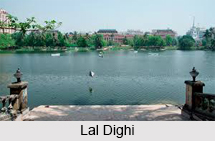 Lal Dighi is a body of water in the middle of B. B. D. Bagh, earlier known as Tank Square or Dalhousie Square.
Lal Dighi is a body of water in the middle of B. B. D. Bagh, earlier known as Tank Square or Dalhousie Square.
Location of Lal Dighi
Lal Dighi is located in the heart of Kolkata, West Bengal. Now it is maintained by the Government of West Bengal and Kolkata Municipal Corporation.
History of Lal Dighi
Lal Dighi was known as Dihi Kalikata in medieval era, when Kolkata was a village. It was there before the arrival of Job Charnock. Sabarna Roy Choudhury had a court-house and a temple of its family deity Shyam Rai, near Lal Dighi. It was so named possibly because of the red colour the water acquired during dol, the festival of colours. The court-house was first taken on rent and later purchased by the British East India Company.
Some say that the reflection of the red colour of the old fort used to sparkle in the water of the tank and so it acquired its name. According to another school of belief, Lalchand Basak had dug the immense pond and it came to be known as Lal Dighi after his name. Another source states that the tank was dug by either Mukundaram Seth of Gobindapur or his son. He had a court house there, where dol festival was celebrated in a grand way. The tank became red or crimson with the colours used and hence the name.
Environment of Lal Dighi in Medieval Era
The nearby area of Lal Dighi in British era had jungles, which is now the posh busy area of Kolkata. No one drank water from that tank but sometimes dropped fishing lines in the afternoons or embarked upon swimming competitions. The water in the tank was protected for possible use in case of a sudden fire somewhere. The natives were prohibited from going there.
Lal Dighi in Modern India
It was deepened and lengthened in 1709 and converted from a dirty pond full of weeds and noxious matter into a much needed reservoir of sweet water. This was known as Tank Square. It covers upwards of 25 acres (100,000 m2) of ground. "It was dug†says the Dutch admiral Stavorinus who visited the settlement in 1770, "by order of Government, to provide the inhabitants of Calcutta with water, which is very sweet and pleasant. The number of springs which it contains makes the water in it almost on the same level. It was railed around so that no one can have a washing there. The tank was formerly more extensive, but was cleansed and embanked completely in Warren Hastings" time. It has always been esteemed the sweetest water in Calcutta, and until the introduction of municipal water supply, was the chief source of supply of drinking water to the European community.
Battle of Lal Dighi
On 18th June 1756, the Battle of Lal Dighi was fought between Siraj ud-Daulah, the last independent Nawab of Bengal and the forces of British East India Company led by Robert Clive, leading to withdrawal of the British from Kalikata with the villages Gobindapur and Sutanati, till their victory in the Battle of Plassey at Murshidabad now in Murshidabad District on 23rd June 1757.
Related Articles
Capital Cities of India
History of Kolkata
Kolkata, Indian City, West Bengal
Culture of Kolkata
Economy of Kolkata
West Bengal, Indian State
Monuments in Kolkata, West Bengal Monuments
History of Bengali Theatre
Birla Planetarium, Kolkata
Siraj-Ud-Daulah, Nawab of Bengal
Battle of Plassey
Mir Jafar, Nawab of Bengal
Minhaj al-Siraj Juzjani
British Empire in India
Impact of British Rule in India
British Military Architecture in India
British East India Company
Indian English literature During British India
Robert Clive, Founder of British Empire in India
Dual Government of Bengal, Modern History of India
Battle of Buxar
Anglo-Mysore Wars
Significance of Battle of Plassey
Battle of Laswari, Maratha Empire
Battle of Rajmahal, Indian History



















